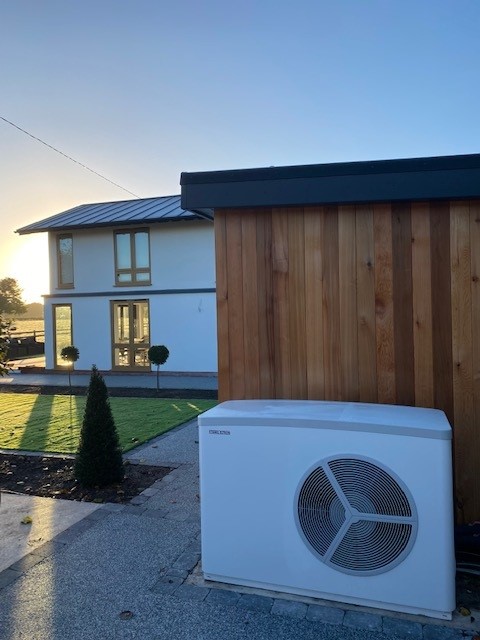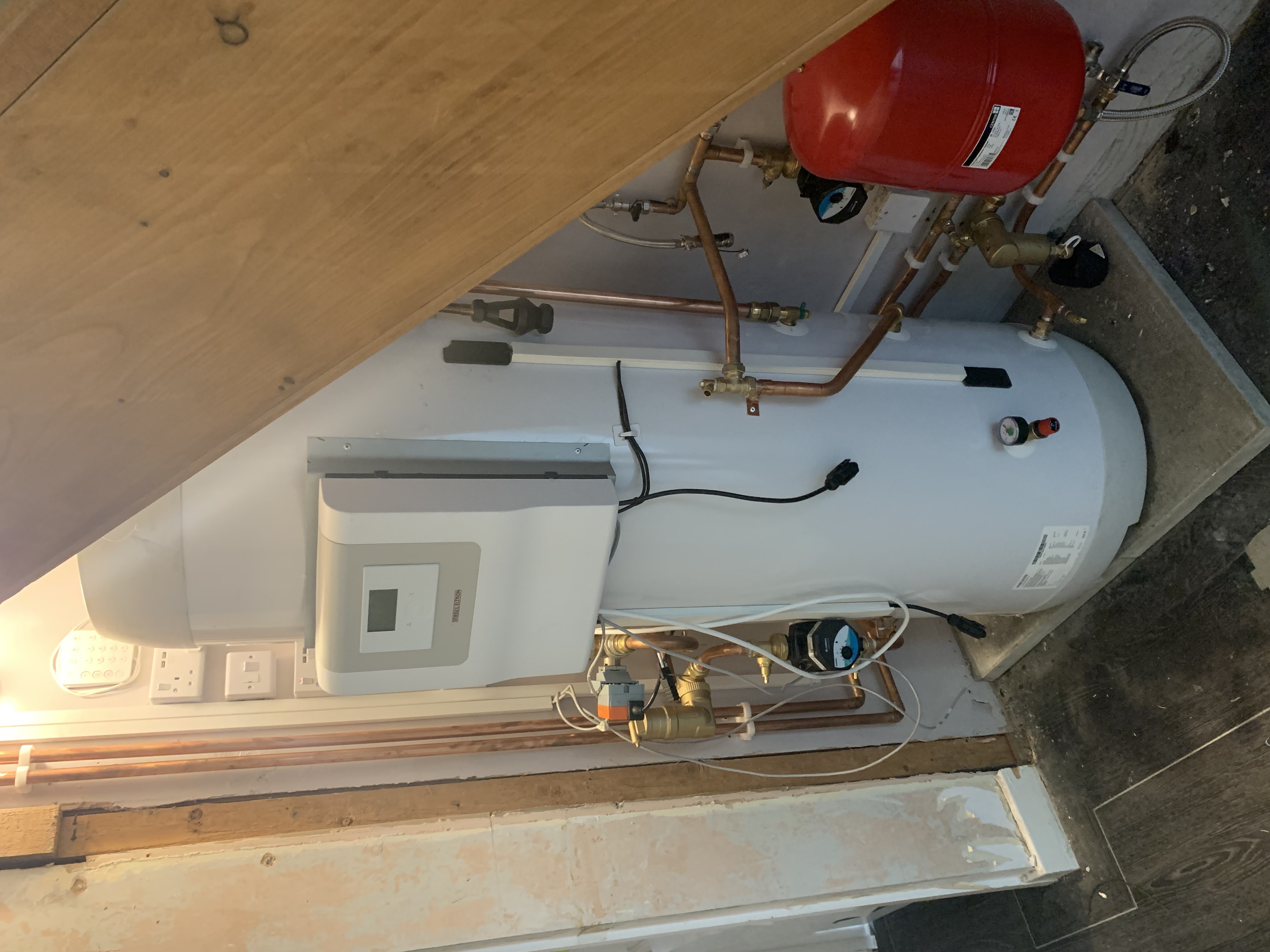All about air source heat pumps
Wondering what an air source heat pump would be like in your home? We give you the low down and answer some frequently asked questions!
Air source heat pumps – sometimes called air-to-water heat pumps - are a tried and tested alternative to conventional fossil fuel boilers for heating and hot water in homes and businesses.
STIEBEL ELTRON have nearly 50 years of experience manufacturing and designing heat pump systems and have worked on projects installing them in all sorts of properties from the most futuristic new build to historic palaces.
With the right design and installation an air source heat pump can work to provide heating in almost any setting.
How do air source heat pumps work?
Heat pumps are often explained as an air conditioner unit or refrigerator in reverse - they have a heat exchanger that extracts energy from the air and stores it in water for use in your home.
Air source heat pump systems have a outdoor unit that extracts heat from the outside air and transfers it to indoor stores of water for your heating circuit - be that radiators or underfloor heating - and hot water needs. Want to find out more about how heat pumps work in detail? See our detailed information on how heat pumps work.
Do air source heat pumps work in winter?
You may have seen some claims that heat pumps can’t work well in the UK climate because it gets too cold and our homes are too badly insulated. As already discussed with the right design and installation this is simply not true – even simple changes such as switching to larger radiators can make a heat pumps a viable option for an older home.
Heat pumps are widely adopted in some of the coldest parts of the world and our models can operate efficiently down to -25°C.
Heat pumps use a refrigerant circuit that compresses gas to create heat. The refrigerant is in liquid form until it absorbs heat (from the air or ground) and ‘boils’ to become a gas. This refrigerant gas is then compressed, creating heat and this heat energy is then transferred for use in the heating system of your home.
If the external air temperature is above the temperature at which the refrigerant in the heat pump boils – typically -50°C – your heat pump can keep working.
What space do I need for an air source heat pump?
Outside space for an air source heat pump
he first requirement is some outside space to install the heat pump unit itself. This is relatively modest – you need just a few few metres square for the unit and clearance around it to allow free air flow. They are often installed by walls to minimize the impact, and this is fine as long as you follow the instructions about minimum clearances to any structure or screening.
STIEBEL ELTRON heat pumps are designed to be whisper quiet, but it is always good practice to install an air source heat pump where noise is unlikely to be an issue when windows are open.
Indoor space for an air source heat pump
You will also need some space inside your home for a hot water cylinder, the heat pump controller and other smaller accessories like expansion vessels. In many cases most of these components are housed in a single “system cylinder” which holds all the tanks and hydraulic components for your heat pump system in one unit.
The exact space required depends on how big your property is – bigger homes need more space for hot water storage for example. However, for smaller homes we see an increasing number of compact installations fitted into an under-stair cupboard, old airing cupboard or in the eaves space of a loft.


Is my home suitable for an air source heat pump? Do I need to change to underfloor heating system?
Heat pumps are most efficient when producing lower water temperatures than those typically produced by boilers. Whereas a boiler might be set to produce water at 60-80°C, heat pumps give the best savings compared to fossil fuels when run at 35-55°C.
These lower temperatures are ideal for underfloor heating or fan coil radiators which is why is can be a good idea to replace existing radiators with them if possible. But it is not essential and lower heating bills can be achieved even with existing emitters.
New or recently built homes (from about 2000 onwards) have low heat losses - very little heat is allowed to escape through the fabric of the walls, floor, roof and windows because of standards set by building regulations. They are thus ideal for low flow temperature heating as you don’t generally need high flow temperatures to achieve comfort levels easily. These homes can usually be adapted to an air source heat pump system with fairly little change required.
You may wish to increase the size of some radiators in a wet central heating system or install fan coil radiators in some areas if you do not already have underfloor heating throughout. Good installers will advise you on this.
There is no doubt that older homes will see more benefit from the efficiency of a heat pump if you maximise insulation. You will also need to address any recommendations for cavity wall or loft insulation on your Energy Performance Certificate (EPC) if you want to eligible for funding from the BUS scheme. However, this is equally true of any heating system; more insulation will mean higher efficiency and lower running costs.
The fact that you may be limited in the changes you are able to make does not preclude the application of a heat pump. You will probably need a larger heat pump than a newer home of the same size – perhaps more than one if your home is large. You will therefore need to ascertain that your electrical supply can support electrical load this represents, and that the cost-benefit analysis still works.
Heat pumps generally win out on running costs by using significantly less units of power to achieve the same level of heat as a fossil fuel boiler. As they use energy to extract more energy from the environment than is put in in the first place (for air source heat pumps 1kW of electrical energy is used to generate 3 or more kWs of heat in an efficient system) they can be cheaper to run even if electricity is more expensive per unit than fossil fuels.
Obviously if your expected heat pump efficiency falls to a level below parity with a fossil fuels your running costs would be higher and there are other considerations like acceptable response times in older properties. If this all sounds complicated do not despair! We can talk you through the specifics of how a design might be made to work for your home and help you find a local contractor who can calculate your likely cost savings. We have experience of successfully applying air source heat pumps to buildings of all ages with high efficiencies.
Find out more about the Boiler Upgrade SchemeWhat does an air source heat pump sound like?
Air source heat pumps have higher noise levels than ground source heat pumps, as several thousand cubic meters of air have to be blown through the device daily. Thanks to constant further development, modern devices are many times quieter than 10 or 15 years ago. Don’t forget that, unlike a boiler, your air source unit will be outside and so careful planning of the location can eliminate any issues with sound.
All STIEBEL ELTRON heat pumps have market-leading low sound emissions and come with “silent” programs that can be set for night time operation. Our compressor and electronics are encased in a sound-insulated chamber to reduce noise as much as possible.
Find out more about heat pumps and noise here
How much does an air source heat pump cost?
The government is currently offering grants of £7500 under the Boiler Replacement Scheme for air source heat pumps that replace fossil fuel boilers. Whilst this will make a significant contribution towards the cost of an installation, you should be prepared to find some extra money to meet additional installation costs.
The exact amount is difficult to quantify without a full review of your property as it will depend on the size of your home and the changes that you want or need to make during the conversion from natural heat out. Typical costs for installation of an air source heat pump in an average home are often quoted as £8,000-£15,000.
What are the benefits of an air source heat pump?
The pros of heat pumps are:
- Lower carbon emissions – electricity is an increasingly green source of energy generated by renewable sources.
- Unlike conventional boilers an air source heat pump can be used for both heating and cooling, providing comfort all year round.
- Running costs - your heating bills - can be lower, particularly if generate your own electricity from solar panels which gives you independence from fossil fuel price fluctuations.
- Increases the EPC rating on your home, which can improve its value.
Are there any downsides or differences using an air source heat pump to heat my home compared to gas boilers?
Air source heat pump response times
Compared to traditional boilers, air source heat pumps can be slower to respond to any changes you make to your heating programme because they operate at lower temperatures. However, this potential downside can really be an advantage if you adapt to your new way of heating.
It is generally better to leave heat pumps running without switching them off completely to maintain the temperature of your home. Instead of turning the heating off at night or when you are at work as you might with a conventional heating system, you set a lower temperature for these “off” periods so that the system only has to recover a few degrees for “heating on” periods. This actually means overall greater comfort – no getting chilled if you have to get up in the night or come home earlier than expected! And because this way of working is more energy efficient for the heat pump, it means that heating bills remain lower too!
Hot water compared to oil or gas boilers
As heat pump systems typically produce water that is not as hot as a boiler, you may find that if you want a very hot bath or shower you need to adjust the mix from your taps to use a little less cold water. However, modern high temperature air source heat pumps do have the ability to produce water at 65-70°C so if you have any concerns about hot water temperatures you can discuss that with your installer during the design of the system. Bear in mind that the lower you run temperatures, the more efficient your system will be.
Our air source heat pump range
Find out more about our range of standard heat pump sets and individual compnents of our systems in our main product area.
Air source heat pump range